
Keeping Humidity Out of Your RV & Tips to Reduce Moisture
Keeping Humidity Out of Your RV & Tips to Reduce Moisture
A helpful guide to avoiding moisture damage in your RV.
By: Kenny & Sabrina Phillips
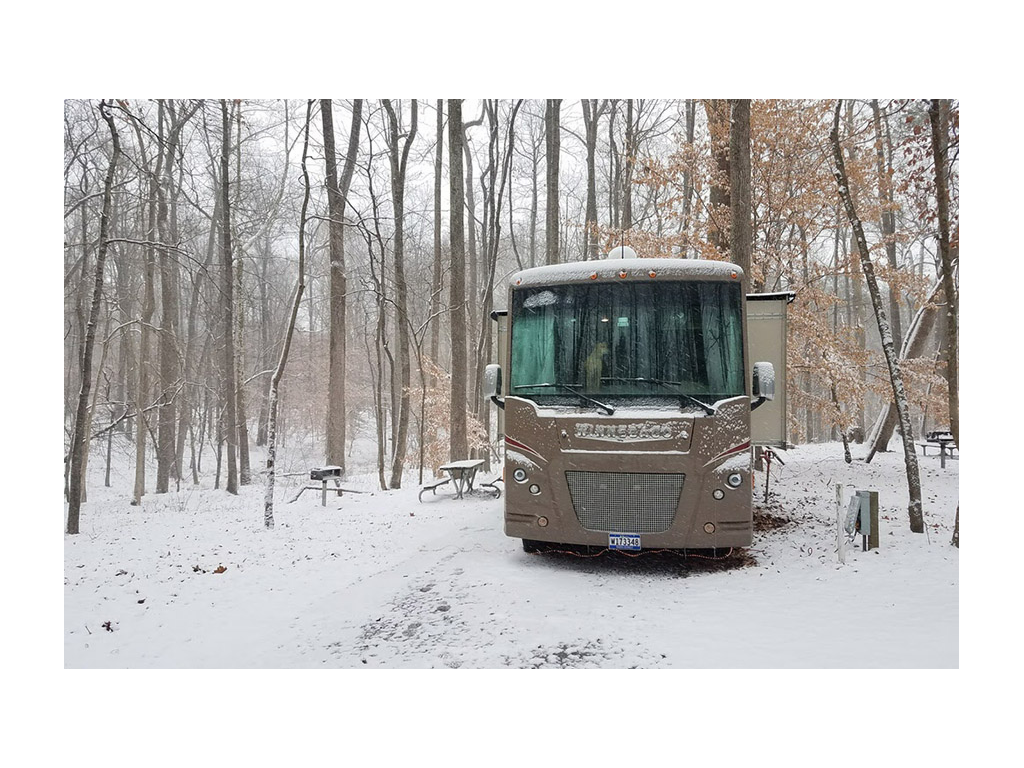
I have never been a fan of humidity. Even as a child growing up in Philadelphia, I preferred the cool dry days of winter over the hot humid days in summer. So, I was happy to hear that RVs do not like humidity either, but why?
Why is High Humidity Bad for You and Your RV?
For one, high humidity can cause damage to your RV, most RVs are constructed with a lot of wood and humidity can cause that wood to warp, expand, and lose structural integrity over time.
Another serious issue with humidity is mold. Mold spores in the air will be able to attach to surfaces in the RV. This can cause health problems, such as increasing issues with asthma, allergies, and other respiratory illnesses.
How Much is Too Much Humidity and How Do You Measure It?
When it comes to humidity for the RV, the lower the better – but we need to be comfortable as well. People, in general, are most comfortable between 35 to 55% humidity. This is also the range that prevents mold from being able to grow.
Sabrina and I do our best to keep the humidity in our RV below 50% and we use temperature and humidity monitors throughout our RV to be sure we are staying close to this goal.
We have an Amir monitor that can track up to four temperature/humidity readings and display them all on one screen. It makes it quick and easy for us to check several areas all at once. We also use a device called a Temp Stick, this device monitors the temperature and humidity inside our RV and can even send us alerts to our phones based on our desired parameters.
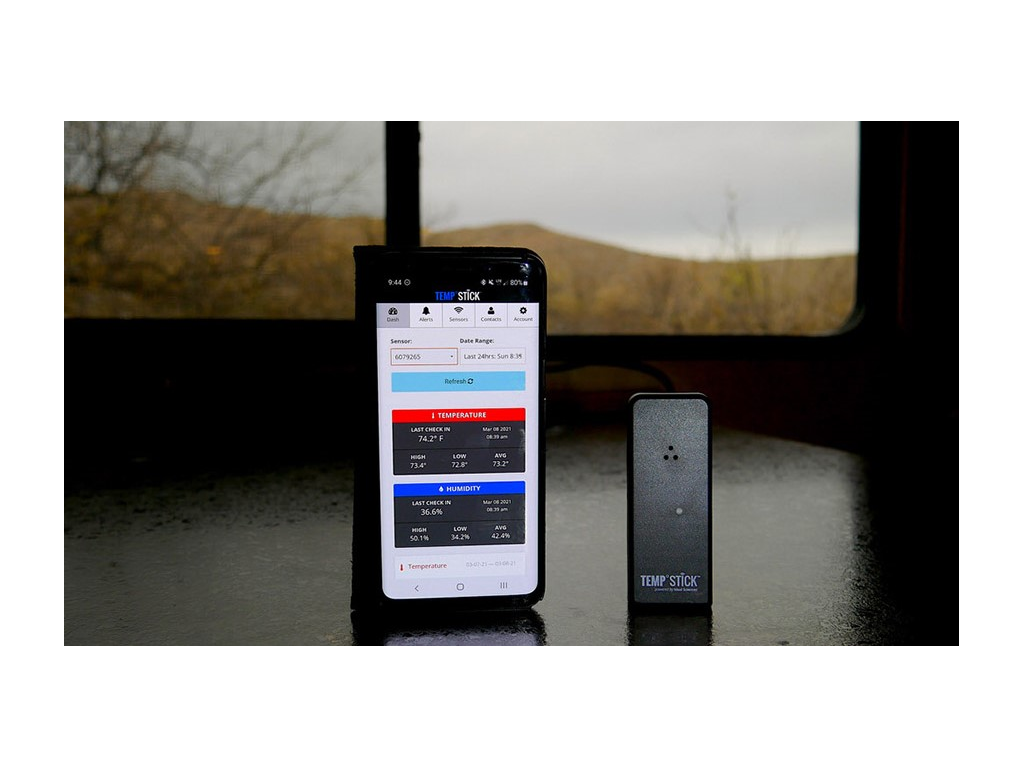
Now that we know what our humidity levels are what can we do to keep them in our desired ranges?
Reducing the Chance of Humidity Entering Your RV
I always think of humidity as being caused by the areas we travel to and weather patterns, but that is only part of it. We cause humidity while cooking, showering, and even breathing. Luckily, there are a few ways to reduce humidity. However, I do recommend first making sure moisture is not getting in the RV from the weather.
Let’s start with checking the seals and gaskets around each window. You just want to make sure everything is looking good and that the seals are tight, and the weep holes are not being blocked by dirt or insect nests.
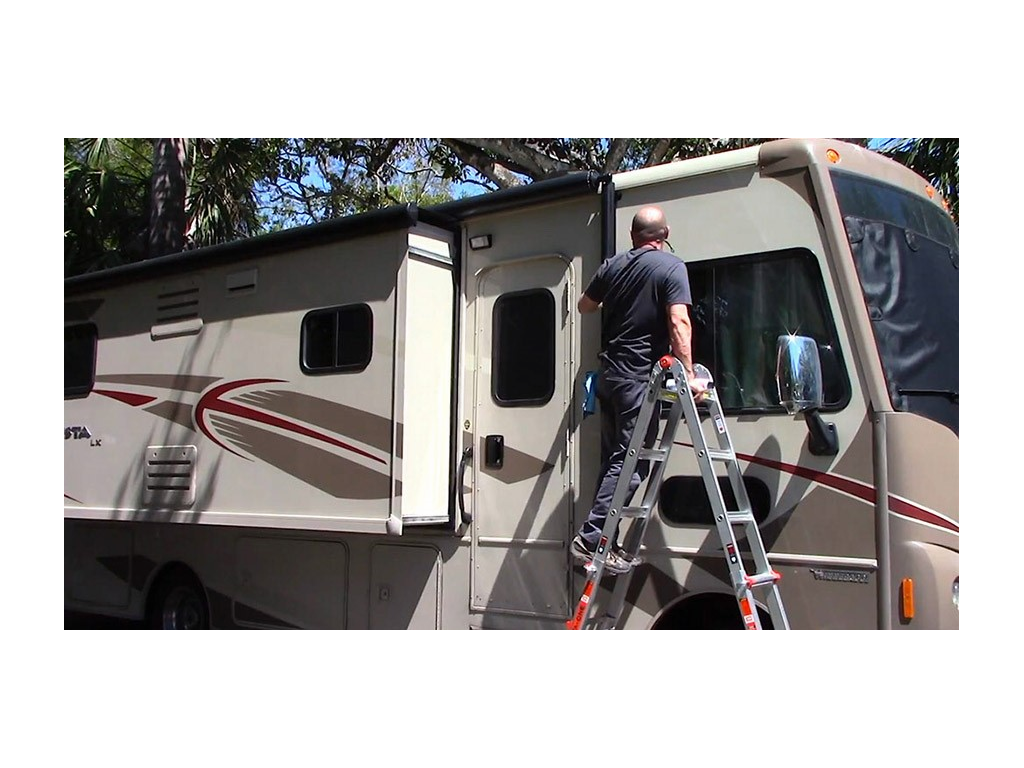
After all the window checks, I like to go up onto the roof. You will want to do a thorough inspection of all of your seals and caulk joints. We are looking to make sure there are no cracks or signs of separation – this will help ensure your roof is watertight and help prevent water from not only getting inside the RV, but also between the exterior panels which can cause delamination.
For more information on roof inspections, check out this article on preventive maintenance where I also talk about inspecting the ceiling inside the RV, especially in cabinets where potential leaks could be hiding.
Ways to Remove Humidity from Inside Your RV
With the roof looking good and knowing water is not seeping in, let’s look at ways to remove humidity from the air inside the RV as well.
In warmer weather, the most effective way is running your A/C units.
An air conditioner not only makes a room cooler, but it also removes humidity from the air. This is why you will see water running down the side of RVs when the A/C is running. The air conditioner is pulling moisture out of the air in the RV and releasing it outside. A tip I have learned is to run the A/C with the fan speed set to auto, this will shut off your fan when the compressor shuts off on the A/C and will prevent your fan from pulling outside humid air back into your RV.
Using your air conditioner is great in the summertime, but what about when it is already cool out? When temperatures start to drop, we naturally want to turn our heat on in the RV. But we have found that running the furnace increases humidity levels in our RV. To help keep humidity down in cooler climates, we use a space heater as well as DampRid products.
A space heater is a great way to warm up your RV and help reduce humidity.
Space heaters put off what is considered dry heat. They will only help reduce humidity by a small amount, but the fact that they do not increase humidity levels is why I consider them to have an advantage. They also help save a few bucks in propane during winter months.
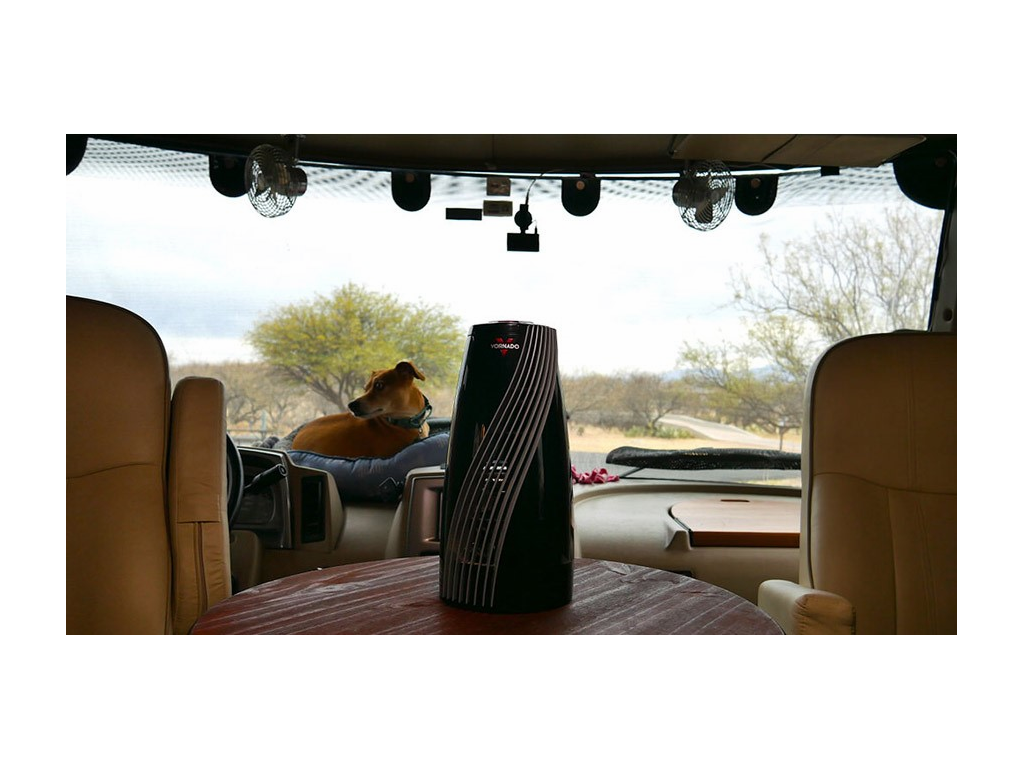
We suggest buying a space heater that has a tip sensor, this will turn the space heater off in case it gets knocked over. We also suggest using space heaters when the outside temperatures are above 32 degrees because your furnace is what keeps the bays and plumbing warm in below-freezing temperatures.
Our second weapon against humidity in the winter is DampRid.
We use the small 10-oz buckets in our bathroom, and we use the DampRid hanging bags in our wardrobe. We like DampRid because it is silent and easy to use, requires no energy, and lasts up to 60 days. We first discovered DampRid while looking for a way to keep our RV dry while it was in storage, we found it worked so well we continued to use it while on the road also.
Another way to remove humidity is by using a dehumidifier.
Sabrina and I do not personally use one in our RV, but some of our friends do and they love them. Dehumidifiers pull moisture out of the air and into a holding container that can then be emptied out daily. The advantage to dehumidifiers is that they work immediately and can drop humidity levels in a room fast.
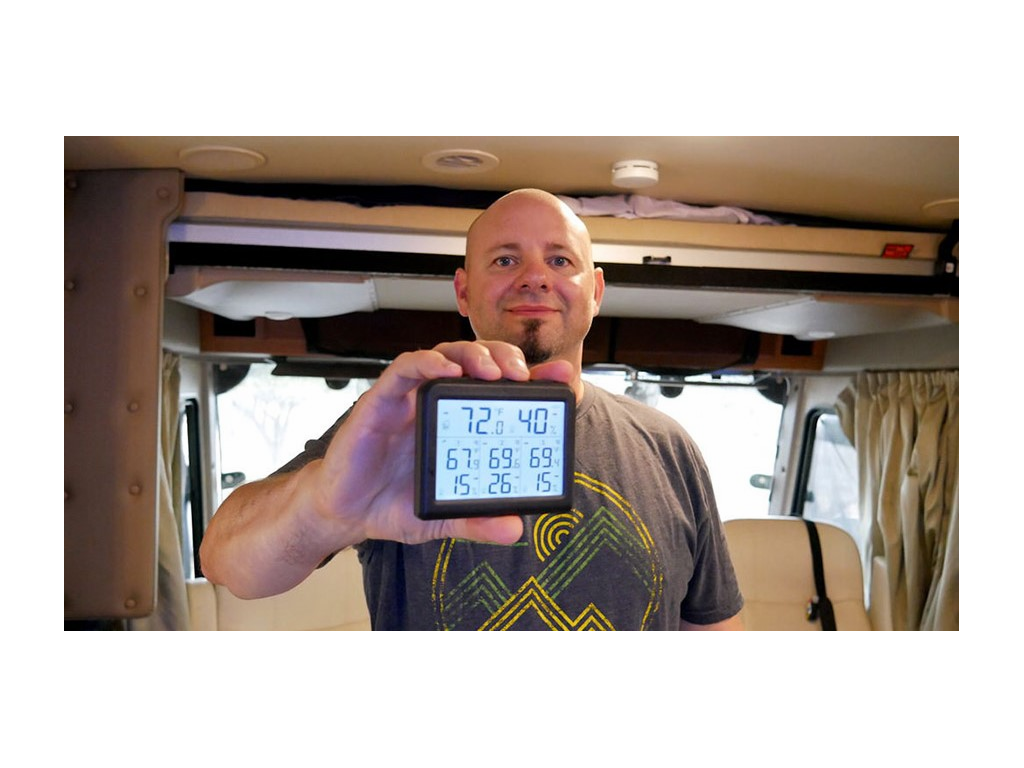
Quick Everyday Tips to Help Reduce Moisture in Your RV
There are some simple things we can do to help reduce moisture in our RVs and these are great habits to incorporate into your everyday RV life.
Be sure to open a vent while taking a shower or cooking. Even if it is humid outside, the water evaporation from boiling water or even a hot shower will be greater than the outside humidity and it would be best to let it escape out of the RV, then you can close everything back up when done.
Quickly clean up any spills from off the floor. Having water on the floor near the base of a counter can be a way for those baseboards to absorb a spill causing swelling, damage, and mold.
Cleaning cargo bay doors and rubber gaskets is how I ensure we have a tight seal around all of our cargo bays. It only takes a few minutes to clean all of them and this helps keep moisture out while driving down wet roads or in heavy downpours of rain. We also keep DampRid in some of our cargo bays when traveling to high humidity areas.
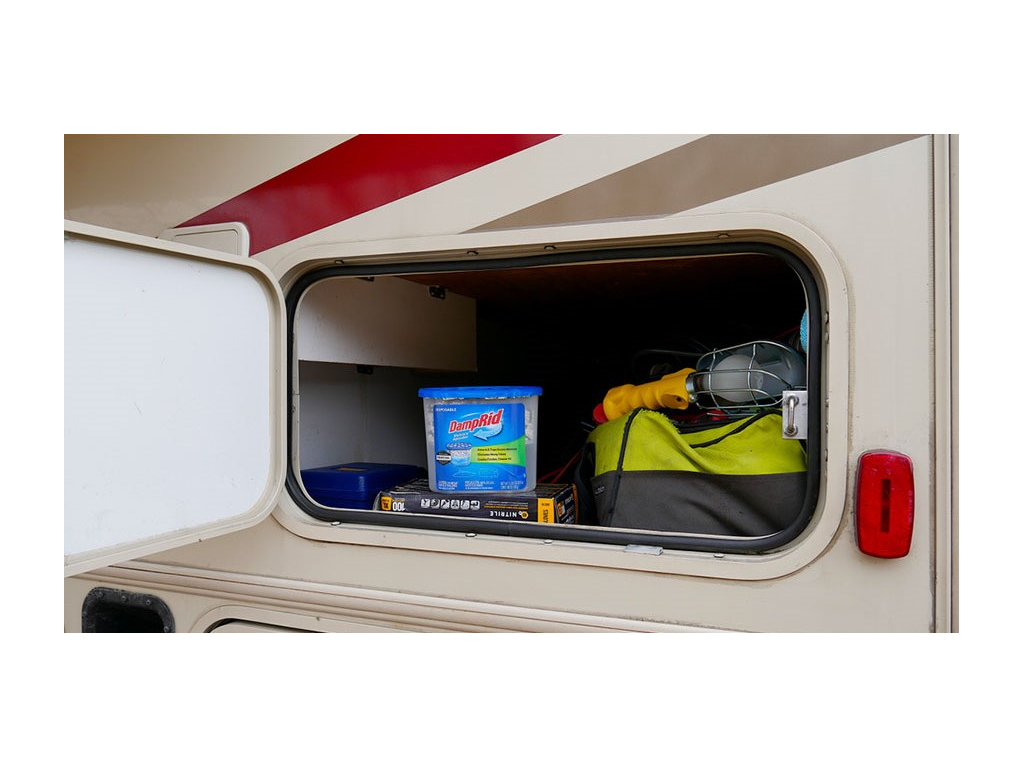
Protecting Your Chassis from Humidity
Here is one final – but especially important – tip I learned while talking with the Winnebago Factory Service Manager, Tom Olson. Tom informed me that we should be cleaning our chassis after traveling from cold climates to warm humid areas. The reason for this is because cold climates use salt on their roads to prevent them from freezing and when you park your RV in a warm humid area, the air there will interact with the salt that has now been sprayed on your chassis and it will start to cause corrosion if not cleaned off.
To learn more about the Winnebago Factory Service center, check out this video interview I did with Tom Olson. Or read the article about my experience at the service center that includes some helpful tips when planning your next trip to Forest City for service.
I hope you find this article helpful for combating humidity in your RV and, as always, I wish you all safe travels!
Comments
Comments on this post are moderated, so they will not appear instantly. All relevant questions and helpful notes are welcome! If you have a service inquiry or question related to your RV, please reach out to the customer care team directly using the phone numbers or contact form on this page .